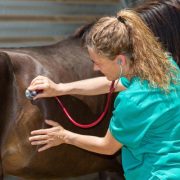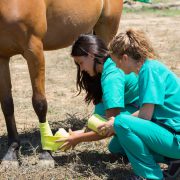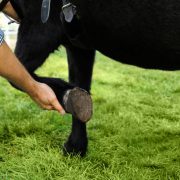Success rates and factors influencing pregnancy outcome after 464 transvaginal ultrasound-guided twin reductions in the mare
Success rates and factors influencing pregnancy outcome after 464 transvaginal ultrasound-guided twin reductions in the mare

our summary:
Sielhorst, J. et al. (2024) Success rates and factors influencing pregnancy outcome after 464 transvaginal ultrasound-guided twin reductions in the mare. Equine Veterinary Journal.
The aim of this retrospective case series study was to investigate the effects of mare age and parity, gestation day on which transvaginal ultrasound-guided aspiration (TUA) was performed, vesicle location, aspiration volume, foetal puncture, medication and operator experience on pregnancy and foaling rates after TUA procedures.
Data was collected from the case records of mares attending two equine reproduction hospitals in Germany on an outpatient basis between 2010-2019. TUAs were carried out according to a standardised procedure. Pregnancy status was determined by ultrasonography at 5-7 days and 3-4 weeks after the TUA was performed. Subsequent pregnancy and foaling results were obtained by follow-up communication. A successful outcome after TUA was defined as the birth of a viable, single foal. Additional variables in the analysis included survival of one singleton 5–7 days and 3–4 weeks after the TUA procedure was performed.
In total, 464 TUA procedures were carried out in 422 mares diagnosed with twin pregnancies. Of the twin pregnancies in the study 74.4% (267/359) were unilaterally fixed and 25.6% (92/359) were bilaterally fixed.
At 5-7 days after TUA 57.2% (218/381) mares were pregnant with a viable singleton, 27% (103/381) were no longer pregnant, and 15.7% (60/381) had a persistent twin pregnancy. At 3-4 weeks post TUA, 50.3% (163/324) mares were pregnant with a viable singleton and 40.1% (127/317) went on to deliver a live foal.
The results showed gestational age at TUA affected the success rate of mares delivering a single live foal. If TUA was performed between days 25–29, days 30–34 or days 35–39 of gestation, 64.7% (11/17), 47.4% (63/133) and 39.7% (29/73) mares delivered a single, viable foal, respectively.
Gestation age significantly influenced foaling rates in unilaterally fixed twins but not in the bilaterally fixed twins. There was a negative effect on pregnancy rates in mares in which several punctures of the yolk sac/allantoic cavity were performed. Increasing volumes of fluid aspiration had a negative effect on the probability of the birth of a live foal in both unilaterally as well as bilaterally fixed twin pregnancies.
There was a correlation between operator experience of the TUA procedure and increased pregnancy rates.
Limitations of the study include the retrospective nature and the inconsistent quality of the data contained within patient records. The variable quantity of data available for each case meant that sample sizes varied for all the parameters analysed.
This study provides evidence that acceptable pregnancy and foaling rates can be achieved in mares diagnosed with twins when TUA is performed early in gestation. The study also highlights that improved TUA success can be achieved by limiting the volume of fluid aspirated and avoiding puncture of the embryo/foetus.
The following may also be of interest:
Claiming CPD for reading inFOCUS articles
Reading and reflecting on articles can count towards your CPD, and we have a template to help you with the process.
Image copyright attribute: purplequeue











Leave a Reply
Want to join the discussion?Feel free to contribute!